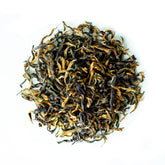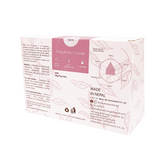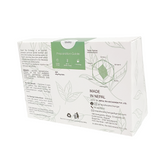Understanding the Impact of Green Tea on Blood Pressure
Introduction: The Broad Spectrum of Green Tea Benefits for Blood Pressure
Green tea is revered not only for its subtlety and variety but also for its broad spectrum of health benefits. Among these, its impact on cardiovascular health, specifically blood pressure management, is one of the most studied and scientifically supported aspects. This deep dive explores how green tea can play a crucial role in maintaining optimal blood pressure levels, with a nuanced look at its biochemical interactions and the subtle, yet potent effects of high-altitude Nepalese green teas.
Understanding Blood Pressure and Green Tea's Role
Blood Pressure Fundamentals
Blood pressure measures the force exerted by blood against artery walls and is a critical indicator of cardiovascular health. Normal functioning requires maintaining blood pressure within a healthy range, typically around 120/80 mmHg. Deviations, especially persistent high or low blood pressure, can lead to significant health issues.
Green Tea's Influence on Vascular Health
Extensive research suggests that green tea enhances vascular health due to its rich content of catechins, particularly epigallocatechin gallate (EGCG). These compounds improve blood vessel function and blood fluidity, which can help normalize blood pressure levels. Studies, including those encapsulated in the comprehensive review "The Impact of Green Tea on Blood Fluidity and Weight Loss," highlight that regular consumption of green tea can have a stabilizing effect on blood pressure, particularly beneficial for those with hypotension.
 The Impact of Green Tea on Blood Pressure: A Scientific Perspective
The Impact of Green Tea on Blood Pressure: A Scientific Perspective
Short-Term and Long-Term Effects
Research detailed in "Effects on Blood Pressure of Drinking Green and Black Tea" reveals that while green tea might slightly elevate blood pressure shortly after consumption, its long-term use contributes to overall cardiovascular stability. This dichotomy highlights the complex interplay between green tea’s caffeine content and its antioxidant properties, each influencing cardiovascular health differently.
A Survey Based Study
A survey conducted in Kathmandu among university students and faculty members provides several insights that could support and enhance the understanding of green tea's impact on health, particularly on low blood pressure:
1. Health Benefits Acknowledgment
The majority of respondents, about 85.38%, believe that organic green tea is beneficial for health. They recognize green tea's potential in reducing weight, fighting infections, and its antioxidant and anticancer properties. This wide acknowledgment reflects a well-informed community that values green tea for its multiple health benefits .
2. Seasonal Usage


Fig 1: Seasonal uses and health benefits of green tea
The survey also highlighted that a significant number of participants, 85.38%, prefer consuming green tea in the winter season. This seasonal preference suggests that green tea is particularly valued during colder months, potentially for its warming effects and perceived benefits in boosting immunity during the winter .
3. Antioxidant and Anticancer Properties


Fig 2: Potential of Green Tea
The study notes that a substantial portion of participants believes in the antioxidant (66.13%) and anticancer (78.23%) properties of green tea. These properties are crucial because antioxidants can help manage blood pressure by preventing vascular damage, and the overall health benefits contribute to maintaining a healthy cardiovascular system .
4. General Perception and Usage

Fig 3: Tea type and quality used by participants
Green tea is highly regarded among the younger demographic in Kathmandu, with a significant preference over other types of tea like milk tea. This preference not only underscores the popularity of green tea but also indicates a cultural shift towards health-conscious choices among the youth .
Exemplary Source: High-Altitude Green Teas from Nepal
Unique Attributes of High-Altitude Teas
High-altitude regions like Ilam in Nepal, known for their pristine environments and rich tea-growing heritage, produce green teas that are not only aromatic and flavorful but also exceptionally rich in health-promoting antioxidants. The slow growth rates at high elevations allow tea leaves to develop a denser profile of these beneficial compounds.
Sustainable Practices Enhancing Tea Quality
Teas grown in these regions are often cultivated using organic farming methods that eschew synthetic pesticides and fertilizers, ensuring that each leaf is not only healthier but also more environmentally sustainable. For those looking to try some of the finest green teas available, high-altitude Nepalese teas offer a sublime experience that combines quality with the added benefit of supporting sustainable agricultural practices.
Practical Tips for Optimizing Green Tea Consumption
Brewing for Health Benefits
To maximize the potential health benefits, green tea should be brewed at temperatures between 160°F to 180°F and steeped for 1 to 3 minutes. This method preserves the integrity of its catechins, avoiding excessive bitterness while enhancing the tea's health-promoting properties.
Consumption Recommendations
Moderate consumption, typically 2 to 3 cups per day, is ideal, particularly for those new to green tea or managing specific health conditions like low blood pressure. It’s also advisable to consume green tea between meals to minimize its impact on iron absorption.
Conclusion: Green Tea as a Keystone of Dietary Health Strategies
Incorporating green tea into one's dietary regimen offers more than just a pleasant beverage experience; it contributes significantly to cardiovascular health and overall well-being. For those exploring the vast world of teas, choosing high-quality options like those from the highlands of Nepal can enhance this experience, offering superior taste and health benefits supported by sustainable, eco-friendly agriculture.
FAQs
Is green tea safe for people with cardiovascular diseases?
Yes, when consumed in moderation, green tea is safe and can be beneficial for cardiovascular health due to its antioxidant properties. However, it is crucial to consult with a healthcare provider for personalized advice.
Can green tea replace blood pressure medication?
No, green tea should be considered a complementary approach rather than a replacement for prescribed medication. Always consult with a healthcare professional before making any significant changes to your treatment plan.
How does green tea affect systolic blood pressure?
Green tea can have a stabilizing effect on systolic blood pressure due to its vasodilating properties, which help improve blood vessel function.
Are there any side effects of drinking green tea daily?
When consumed within the recommended limits, green tea is generally safe for most people. Excessive consumption might lead to side effects due to caffeine, such as insomnia, nervousness, or a rapid heartbeat.
Can green tea help in managing type 2 diabetes?
Green tea may assist in managing blood sugar levels due to its polyphenolic compounds, making it a beneficial addition for those managing type 2 diabetes.




















